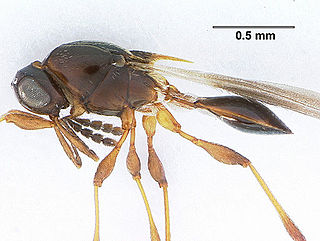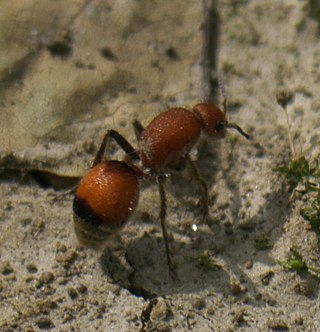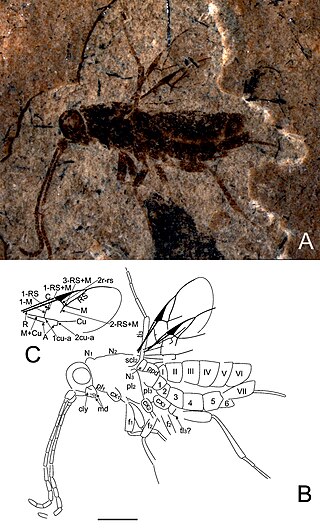Michael S. Engel, FLS, FRES is an American paleontologist and entomologist, notable for contributions to insect evolutionary biology and classification. In connection with his studies he has undertaken field expeditions in Central Asia, Asia Minor, the Levant, Arabia, eastern Africa, the high Arctic, and South and North America, and has published more than 983 papers in scientific journals and over 925 new living and fossil species. Some of Engel's research images were included in exhibitions on the aesthetic value of scientific imagery.

Xiphydriidae are a family of wood wasps that includes around 150 species. They are located all over the world including North and South America, Australia, Europe, and others. Xiphydriidae larvae are wood borers in dead trees or branches of a range of trees. They are characterized as having long and skinny necks with dome-shaped heads. The oldest fossils of the group are from the mid Cretaceous.

The Mymarommatidae, sometimes referred to as false fairy wasps. are a very small family of microscopic parasitic wasps. Only about half of the known species are living taxa, but they are found worldwide.

The Hymenopteran superfamily of parasitoid wasps, Platygastroidea, has often been treated as a lineage within the superfamily Proctotrupoidea, but most classifications since 1977 have recognized it as an independent group within the Proctotrupomorpha. It is presently has some 4000 described species. They are exclusively parasitic in nature.

Anaxyelidae is a family of incense cedar wood wasps in the order Hymenoptera. It contains only one living genus, Syntexis, which has only a single species, native to Western North America. Fossils of the family extend back to the Middle Jurassic, belonging to over a dozen extinct genera, with a particularly high diversity during the Early Cretaceous. Syntexis lay eggs in the sapwood of conifers, preferring recently burnt wood.

Trigonalidae is one of the more unusual families of hymenopteran insects, of indeterminate affinity within the suborder Apocrita, and presently placed in a unique superfamily, Trigonaloidea, and the only extant taxon in the superfamily. The other putative related taxon is the extinct family Maimetshidae, known from the Cretaceous period. Trigonalidae are divided into 2 subfamilies; Orthogonalinae and Trigonalinae. These wasps are extremely rare, but surprisingly diverse, with over 90 species in 16 genera, and are known from all parts of the world. It is possibly the sister group to all Aculeata.

The Mymarommatoidea are a very small superfamily of microscopic fairyfly-like parasitic wasps. It contains only a single living family, Mymarommatidae, and three other extinct families known from Cretaceous aged amber. Less than half of all described species are living taxa, but they are known from all parts of the world. Undoubtedly, many more await discovery, as they are easily overlooked and difficult to study due to their extremely small size.

Proctotrupoidea is a hymenopteran superfamily containing seven extant families, though others have been recognized in the past, most of these having been removed to a recently erected superfamily Diaprioidea. Of the remaining families, only Proctotrupidae contains a substantial number of species, with over 400 described. The others are small, often relictual groups. See links for individual families for details of life history and diversity.
Jean-Jacques Kieffer was a French naturalist and entomologist who specialised in the study of parasitic insects. Educated as a priest, Kieffer taught natural science in Bitche, Lorraine while working on the description and classification of insects. His work and publications later became a predominant source of description and classification for entomologists in the early 20th century, in particular with regard to parasitoid wasps, midges, and mosquitos.

The Baltic region is home to the largest known deposit of amber, called Baltic amber or succinite. It was produced sometime during the Eocene epoch, but exactly when is controversial. It has been estimated that these forests created more than 100,000 tons of amber. Today, more than 90% of the world's amber comes from Kaliningrad Oblast of Russia. It is a major source of income for the region; the local Kaliningrad Amber Combine extracted 250 tonnes of it in 2014, 400 tonnes in 2015.

Maaminga is a genus of parasitic wasps containing two species and constituting the family Maamingidae. So far only known from New Zealand, the two named species are Maaminga marrisi and M. rangi. The genus name derives from the Māori word "māminga", simply translated as "trickster" as the species evaded discovery for so long.

Diaprioidea is a hymenopteran superfamily containing five extant families, though in the past these families were included in the superfamily Proctotrupoidea.

Helorus is a genus of wasps in the family Heloridae. There are about 12 described species in Helorus, found worldwide Members of the genus are parasitic on green lacewings. The oldest fossils are from Eocene aged Baltic amber.

Pompiloidea is a superfamily that includes spider wasps and velvet ants, among others. in the order Hymenoptera. There are 4 families in Pompiloidea.

Vanhornia is a genus of parasitic wasps. Of the four known species, V. eucnemidarum (type) is widespread across North America, V. leileri is widespread across the Palearctic, V. quizhouensis is found in South China and Thailand, and V. yurii is found in Northeast Asia. Members of Vanhornia are parasitoids on beetles belonging to the family Eucnemidae.
The Gallorommatidae is an extinct family of microscopic parasitoid wasps, belonging to the Mymarommatoidea. It is known from several species found in Cretaceous aged amber.
Ismaridae is a family of insects belonging to the order Hymenoptera. About 50 species are known in this small relictual group; all the species for which the biology is known appear to be hyperparasitoids that parasitize Dryinidae.

Peleserphidae is an extinct family of wasps belonging to the superfamily Proctotrupoidea. It is currently known from four species in three genera. One (Arkadiserphus) from the Middle-Late Jurassic Karabastau Formation of Kazakhstan, and the others from mid Cretaceous Burmese amber from Myanmar.














